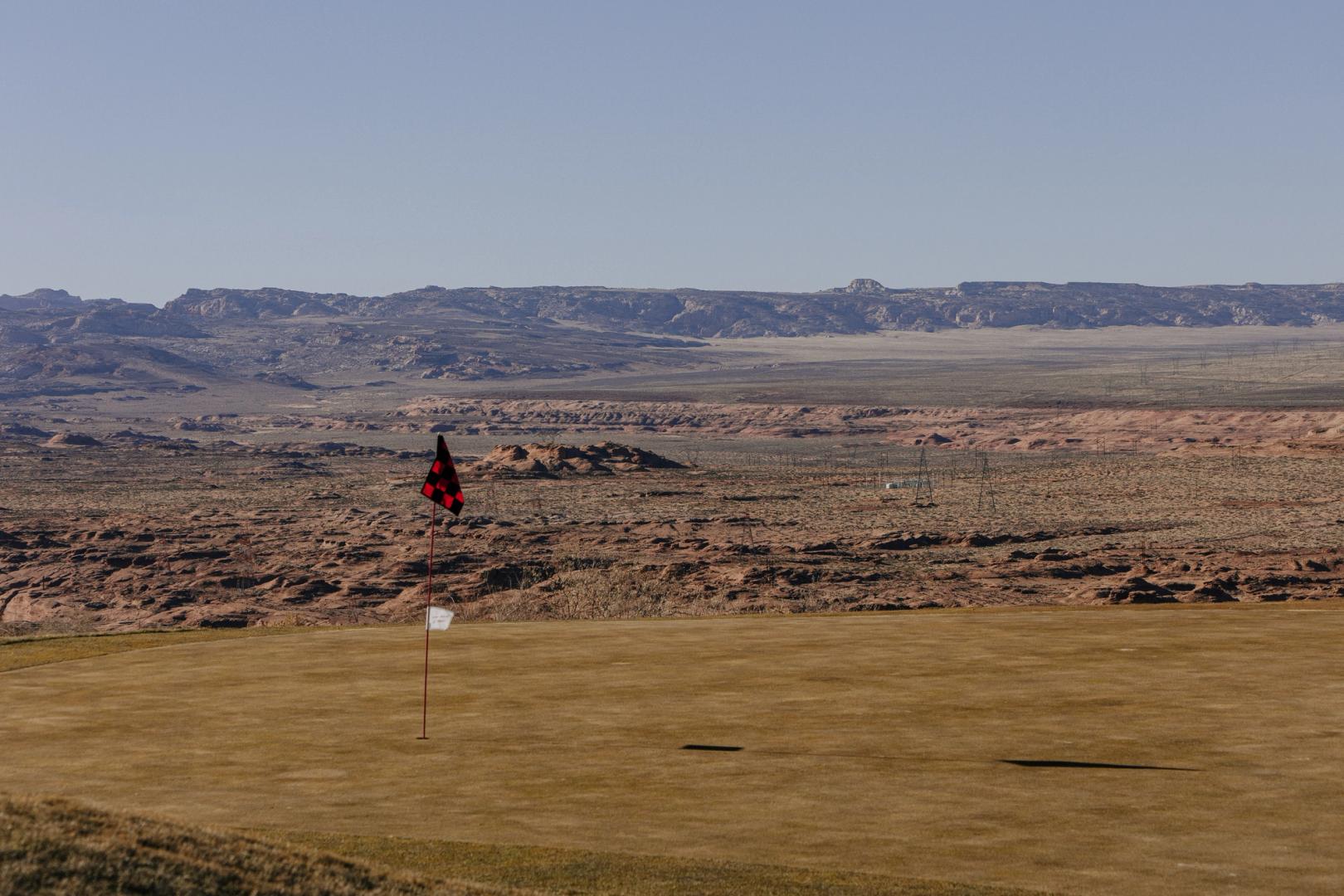
Red Heritage
We venture further north, Western movie landscapes flying past the van windows, but our eyes are set on Lake Powell Golf Course. Nestled on the border of Utah and Arizona, the course is an oasis of green amid endless red sand and towering rock formations. Our fourball today includes Tomas and Joseph Secody, members of the Navajo Nation and founders of Red Heritage, a Native American performing arts group.
Tomas isn’t a seasoned golfer—he admits he’s lucky to get 150 yards off the tee—but what he lacks in distance, he more than makes up for in perspective. “Golf is becoming more popular among the Navajo,” Tomas tells me as we walk down the fairway. “Not just here, but across other tribes too. It’s something to take your mind off things, something to do when you’re surrounded by open land.”
Driving through the reservation, there’s a striking vastness to the landscape—miles of open desert, dotted with small homes and wide horizons. “Growing up, the land is your playground,” Tomas adds. “But as you get older, you start looking for other ways to connect. Golf becomes one of those ways.”
He laughs when he talks about “Rez golf,” a version of the game played on makeshift courses carved into the dirt. “Some Navajos build their own little courses in their backyards—just holes in the dirt—but it keeps people out of trouble.”
As we approach the back nine, Joseph shares more about the land we’re playing on. “The golf course here isn’t just for golfing. High school kids run cross-country races here, and families come for picnics. It’s part of the community.”
I ask how many people in the area play the game, expecting a modest number. Joseph surprises me. “About 30% of the town,” he estimates. Considering that 60% of Page’s 10,000 residents are Navajo, it’s clear that the game makes deeper inroads into the culture than I anticipate.
On the 11th hole, Joseph tees up for a semi-blind shot over a rocky outcrop. “I’ve played golf since I was four,” he mentions, adjusting his stance. “But I’ve been doing Native American dancing all my life, and I hope the timing and rhythm from that eventually translates into my golf.” His shot soars, disappearing onto the tiny sliver of fairway. The Red Heritage group exists to continue Navajo traditions and educate people about their past. Joseph and Tomas are visibly impassioned by the project.
Soon we arrive at the 13th hole, affectionately known as “The Cliff Shot.” It’s a 125-yard downhill par three, offering views towards Lake Powell, and the Vermillion Cliffs. These are some of the greatest sights in all of the USA, and they’re available from one vantage point.
“Golf broadens your horizons. It’s a vehicle for adventure and relationships,” says Joseph, swinging and sending the ball into the vastness below. “You don’t have to be amazing to play,” he adds, laughing. “You can just go out there, have a good time, and that’s the beauty of it.”
As we finish our round and the sun dips behind the cliffs, the temperature drops at an alarming rate, but Joseph insists on showing us something important to him before we head into the clubhouse for warmth.
Native American hoop dancing is a vibrant, dynamic form of storytelling through movement, deeply rooted in Indigenous culture and tradition. It involves the use of multiple hoops—between 5 and 30—that dancers manipulate to create intricate shapes and symbols, representing elements from nature, animals, and the cycles of life. These shapes might depict the eagle, the butterfly, the snake, or even more abstract representations like the sun or the circle of life.
As we gather, Joseph begins to move, skillfully weaving multiple hoops into intricate shapes, his body flowing with a rhythm that feels both ancient and immediate.
“Each hoop represents a struggle in life,” Joseph explains. “This hoop might represent your job; maybe you have a tough job,” he tosses a hoop to the ground. “This hoop might represent school; sometimes school is tough,” another hoop goes on the pile. “This hoop might be your relationship; that can come with challenges.” Another. “Maybe this hoop is your golf game; that can be frustrating.” He smiles this time.
Joseph reaches his hand into the messy pile of hoops and tugs at one through the middle. “They’re scattered at first, but as you work through them, you can create something beautiful.” As Joseph lifts the central hoop, the surrounding ones fall into place, forming a perfect, robust sphere. “And you can rebuild your world.”